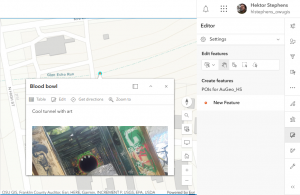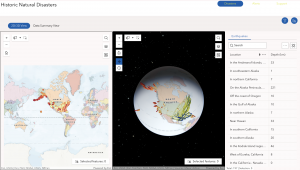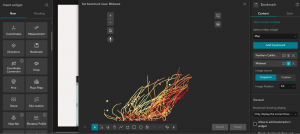Chapter 3:
SO experience builder just kind of modifies and combines apps and widgets? I like how it interconnects
Please don’t make me use the developer one my computer is crying
I kind of feel like I’m making an overcomplicated powerpoint again.. Therefore I chose spin animation instead of zoom in.
I put the maps next to each other as I modified the 3D one, so they would be easier to see. Also had some trouble getting it to snap to the corners so I just dragged the maps. Another thing that helped me that the book didn’t mention is being able to select widgets. I added a fade in effect to the image in the data summary and it looked pretty cool in the live view. I kind of wish it would select the hurricane or earthquake on the 3d map instead of just hiding everything else.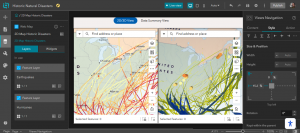
I also adjusted the colors and font in data view to make it look fancy, and I tried to find a way to center the text better but the centering options i could see just moved the text box.
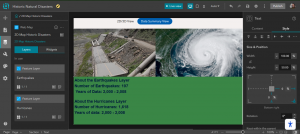
I was very confused at the table part because there was no blank spot, but it turned out the page was wider and I wasn’t zoomed out. I had another issue earlier with the dynamic content where I struggled to find the pane because it popped up hidden in a corner. Are there some weird presets?
The filters and SQL expressions were also a lot like desktop
When it was time to embed the link, I had to paste it into my browser and copy that link because it didn’t accept the shortened one. That’ll be important to remember. Here’s the final product for chapter 3.
CHapter 4:
For my project I think it would be so cool to actually go to metro parks and take my own pictures, and attach them to a map to make my own feature layer. Enabling public attachments would also be a nice way to make it an interactive and collaborative web experience.
Starting on Survey123 and it’s ok so far. I think the imagery with labels basemap will be perfect for my metro parks project
Site kept glitching out and zooming back out to the whole world when I tried to go to Delaware. Eventually I had to refresh it a bunch and allow it to get my location through my computer.
I had to add the rule for showing the recyclable categories in a completely different way than the tutorial said. When I opened the survey on my phone and selected recyclables, the type question came up so I guess whatever I did did the trick!
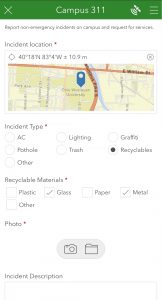
When I started making my own layer and adding fields I noticed that the tutorial had the wrong order to do things in. Choosing the type (integer) is before naming the layer. I think the website has been updated a bit since the book was put out.
The quick capture project was pretty simple to put together and I think I could make something with that for my project. It wouod be a great tool for recording locations and capturing pictures of invasive plants, and maybe i could attach it to a second app that gives a rundown on identifying them for people without a botanical background. Adding images to the forms might help too.

For the AuGeo app, I’ll test that later because I picked a couple places in Columbus, but here’s one of them. I’ll make a note to add them to next week’s post.